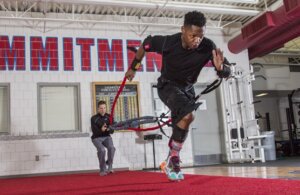How VR and AR Technologies are Revolutionizing Basketball Training and Fan Engagement

In the kinetic sphere of sports, technological progression ceaselessly drives the evolution of athlete preparation and fan interaction. A noteworthy development in recent years is the advent of Virtual Reality (VR) and Augmented Reality (AR) in the realm of basketball. These technologies have catalyzed a revolution in training methods and escalated the fan experience to new dimensions. This essay seeks to navigate the transformative role of VR and AR in basketball training and fan engagement.
Immersive Training and Skill Refinement The impact of VR on basketball training is notably conspicuous in the creation of highly immersive, realistic training environments. By donning a VR headset, players are transported to a virtual basketball court, complete with realistic gameplay scenarios, virtual adversaries, and even simulated crowd noise. The resulting environment allows athletes to hone their skills, foster decision-making abilities, and accrue experience in game-like situations. The fusion of immersion and instantaneous feedback inherent in VR training expedites skill development, assisting athletes in refining their techniques and enhancing their in-game performance.
Performance Analysis via VR and AR Additionally, VR and AR technologies open new avenues for advanced performance analysis. These tools empower coaches and trainers to scrutinize an athlete's movements meticulously, pinpoint areas for enhancement, and provide real-time feedback. The superimposition of virtual elements onto actual footage, courtesy of AR, can illuminate a player's biomechanics for coaches, facilitating data-driven decisions regarding training regimens and strategies.
Tailored Training Regimens The capabilities of VR and AR allow for the design of customized training programs that align with each player's unique abilities and requirements. By utilizing these technologies to track a player's development, coaches can adapt training programs, ensuring that athletes are continually stimulated and motivated to improve. This degree of personalization may significantly influence player development, helping athletes realize their maximum potential on the court.
Elevating Fan Engagement and Experience The influence of VR and AR extends beyond training to redefine how fans engage with basketball. VR transports fans into virtual arenas, granting them access to live games from unique perspectives, fostering a sense of direct participation. This immersive experience strengthens the bond between fans and the game.
AR, meanwhile, enriches the fan experience by overlaying real-time statistics and information onto live game footage. With their smartphones or AR-enabled glasses, fans can access player stats, shot percentages, and other insightful data, thereby enhancing their comprehension of the game and intensifying the thrill of the viewing experience.
Anticipating Future Trajectories for VR and AR in Basketball As VR and AR continue to evolve, their application in basketball is poised to become even more innovative. Potential future developments could involve more advanced training simulations featuring AI-generated opponents that adapt and pose real-time challenges to players, and the integration of biometric data to optimize player performance and prevent injuries. For fans, there may be more interactive and personalized experiences, such as stepping into a player's shoes to experience key moments from their perspective.
To summarize, VR and AR technologies are triggering a seismic shift in how basketball players train and how fans engage with the sport. These avant-garde technologies hold the potential to reshape the basketball landscape, offering unprecedented opportunities for skill development, performance analysis, and immersive fan experiences. As technology continues its relentless advance, the basketball community stands on the cusp of an exhilarating future.

